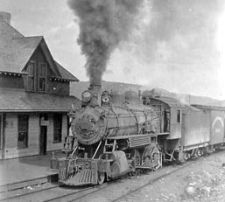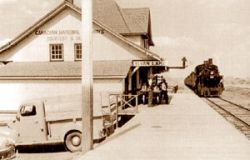|
Canadian Northern
Western Railway
built 1911-12
(Brazeau subdivision of Canadian National Railway 1919-present)
Revised April
2022
Photo descriptions
and credits at bottom of page.
With the discovery of commercially profitable coal deposits in the
Brazeau-Bighorn area, Martin Nordegg received a charter in 1908 to build
the Alberta and Brazeau River Railway Company from a point near Bowden
on the Calgary-Edmonton Railway and follow the valleys of the Red Deer,
Raven and Clearwater Rivers to Rocky Mountain House and Kootenay Plains
and northward to connect with the Grand Trunk Pacific Railway.
With no support from either Canadian Pacific or Grand Trunk Pacific,
Nordegg turned to William McKenzie and Donald Mann of the Canadian
Northern Railway to build the line. A new charter was obtained under
the name of the Canadian Northern Western Railway that included a new route roughly
parallel to the Alberta Central Railway between Red Deer and Rocky
Mountain House.

The Brazeau line originated from south of Stettler on the newly-opened Canadian Northern north-south line in 1911. Construction progressed
quickly west running a few miles north of Red Deer.

During the same
year, the railroad started construction of the long timber trestle across the Blindman River at Burbank
(which is currently shorter after reconstruction and earth fill), constructed a spur line to North Red Deer and
laid steel as far west as Sylvan Lake.

The
competing Alberta Central Railway, which had already surveyed the route, was building a line at the same time from Red Deer, much of the line parallel with the
Canadian Northern Western Railway.
There were many stories of fights and acts of sabotage that broke out
between the two construction crews in their quest to get to the Brazeau
coal fields first.
The Canadian Northern
Western reached Rocky Mountain House before the Alberta Central in 1912,
in part due to a lower standard of initial construction,
although the line wasn't officially opened until 1914. However, the
Alberta Central/Canadian Pacific had already built a good-quality 725'
bridge across the North Saskatchewan River as well as track 2 miles on
each side of it.
 Rather than build a separate bridge across the river, in part because
the federal government wouldn't give permission for an additional
bridge, the Canadian
Northern Western (later part of Canadian National) made an arrangement with Canadian Pacific,
operators of the Alberta Central, to have running
rights on that 4-1/2 mile section of track between Otway and Ullin,
including the new Rocky Mountain House townsite and post office,
referred to by Canadian Pacific as Lochearn on
the east side of the river. (The current Lochearn industrial siding is
about two miles west of the river near the original site of Rocky
Mountain House.) Rather than build a separate bridge across the river, in part because
the federal government wouldn't give permission for an additional
bridge, the Canadian
Northern Western (later part of Canadian National) made an arrangement with Canadian Pacific,
operators of the Alberta Central, to have running
rights on that 4-1/2 mile section of track between Otway and Ullin,
including the new Rocky Mountain House townsite and post office,
referred to by Canadian Pacific as Lochearn on
the east side of the river. (The current Lochearn industrial siding is
about two miles west of the river near the original site of Rocky
Mountain House.)

In return for those running rights across the river,
Canadian Pacific was granted running rights to Nordegg/Brazeau. The
CPR didn't likely exercise those rights for some time as they
had no customers west of Rocky Mountain House and the mines at Nordegg
were owned by the same principals as the CNWR. However, during the
First World War, after the Canadian government took over ownership
of the mines, and especially when the Brazeau Colleries started
manufacturing briquettes in 1937, those rights may have been exercised
but there is no documentation to confirm that. There are reports that, for a time in the
early 1950s, both railways offered ticket services at the Nordegg
station and the station was labeled both 'Nordegg' and 'Brazeau'.
Nordegg became the largest supplier of briquettes in Canada by 1950.

The Brazeau Colleries had been stockpiling coal since late
1911 while waiting for the railway to arrive. It took until late 1913
for the CNWR to reach Nordegg on unballasted rails where a stockpile of 100,000 tons
of coal was waiting to be shipped out. The first shipment left Nordegg
in 1914. For a considerable time Nordegg was a much larger community
than Rocky Mountain House, reaching a population of 3,500.

The
Lochearn station (constructed and owned by Canadian Pacific) at
Rocky Mountain House was used by both railways. A new station
was built in 1920 and shared by both railways with ticket booths for
each. For a time, one side of the station was labeled 'Lochearn' for
the CPR and the other side labeled 'Rocky Mountain House' for the
CNR. Eventually, both sides were labeled 'Rocky Mountain House'. The
station was closed in 1966, sold and burned down in 1967.
Meanwhile, close to Red Deer, a spur line was being constructed south from North Junction near Blackfalds
to North Red Deer in July 1911, intended to be part of a new north-south
Calgary-Edmonton line that was never built. A bridge was erected
across the Red Deer River from North Red Deer near the mouth of Waskasoo
Creek in 1920 and a station (a unique variation of a Canadian National Railway third class
design) and other facilities were constructed where
the Co-op Plaza shopping mall is now located.
Mixed-train passenger service, taking almost 14 hours, operated from
Big Valley to Red Deer and on to Nordegg Mondays, Wednesdays and
Fridays, returning Tuesdays, Thursdays and Saturdays with as many as
30 station stops along the route. CPR provided complementary service
on the Alberta Central subdivision on alternate dates between Red
Deer and Rocky Mountain House.
The railroad became part of the Canadian Government Railways in 1918 and
was absorbed into the newly-created Canadian National Railways in 1919. In
1923, modifications were made at Alix South Junction (on the former
Grand Trunk Pacific Railway) as part of a consolidation and
rationalization of the various railroads comprising the new CNR. Mirror
replaced Big Valley as the divisional point for train crews for the
Brazeau Subdivision as well as the north-south Calgary-Edmonton former
Grand Trunk Pacific line.

The mixed passenger service switched from the Big Valley terminal to
Mirror in the mid to late 1920s using a similar timetable reducing
the trip to around 10 hours. (A timetable from 1925 still shows
the Big Valley connection via Warden and Alix even though the
primary Edmonton-Calgary line had been consolidated through Mirror
and Alix a couple of years earlier).
 With the
bridge over the Red Deer River being washed out in the spring floods a number of
times, the railway abandoned the river crossing at Red Deer in 1941 but continued
service to the city station grounds via a connection to the Canadian
Pacific alongside the present sites of the museum, downtown Safeway store and
Red Deer Lodge. With the
bridge over the Red Deer River being washed out in the spring floods a number of
times, the railway abandoned the river crossing at Red Deer in 1941 but continued
service to the city station grounds via a connection to the Canadian
Pacific alongside the present sites of the museum, downtown Safeway store and
Red Deer Lodge.
The last mine at the Brazeau Colleries in Nordegg was closed in
1955. The line from Rocky Mountain House to Brazeau (Nordegg) was
formally abandoned in 1986 but had had virtually no traffic since
the mines closed thirty years earlier.
The
closure made CN passenger trains between Mirror and Rocky Mountain
House unprofitable. As a result, CN (as well as CP) cancelled all
passenger service on the line including to Red Deer.
 The last steam locomotive
and passenger train to the Red Deer station marked its closure in
1955 but the rail yards continued to be used until they were moved
to the north side of the river in 1961. The station and turntable
were removed in 1960. The Canadian Pacific downtown connection
continued to be partially used until the mid-1970s to serve a few customers
which included Macdonalds Consolidated on the former connection to
the CPR line and for a time when Macdonalds Consolidated relocated. The last steam locomotive
and passenger train to the Red Deer station marked its closure in
1955 but the rail yards continued to be used until they were moved
to the north side of the river in 1961. The station and turntable
were removed in 1960. The Canadian Pacific downtown connection
continued to be partially used until the mid-1970s to serve a few customers
which included Macdonalds Consolidated on the former connection to
the CPR line and for a time when Macdonalds Consolidated relocated.
The Red Deer Recreation Centre was built in 1964 alongside the
former CNR rail
line. The Red Deer Lodge was built in 1975 and the Red Deer Museum
was built in 1980 on land that was freed up when the connector
tracks were removed.

The portion of the Brazeau subdivision from Red Deer to Rocky
Mountain House had limited local traffic serving Sylvan Lake,
Eckville and Rocky Mountain House as well as a few other grain
elevators, a lumber mill and small oil and gas facilities for the
next twenty years. Although diesel power was introduced in the early
1950s, motive power on the line completely switched from steam to
diesel in 1959. When Canadian Pacific abandoned the Alberta Central
subdivision between Benalto and Rocky Mountain House in 1980, the
bridge across the North Saskatchewan River was leased and later sold
to the CNR.
The
railway got a new lease on life in the early 1970s with the construction
of major oil and gas facilities, including the Gulf/Keyera Strachan and Canterra/Husky Ram River sulphur facilities
requiring new spur lines southwest of Rocky Mountain House and the massive
Alberta Gas Ethylene/Nova petro-chemical plants at Joffre and Union
Carbide/Dow plant at Prentiss, both east of Red Deer.
Photo descriptions and credits:
Header: CNR station Red Deer 1955 (Red Deer Archives P7009);
Can. Northern Western Railway under construction north Red Deer ca
1911 (Red Deer Archives P2276 - Fleming);
CNWR Burbank bridge over Blindman River under construction 1911 (Red
Deer Archives P7028);
CNWR construction at Burbank ca 1920 (Red Deer Archives P7575 -
Fleming);
Alberta Central R/CPR bridge over North Saskatchewan River at Rocky
Mountain House (Red Deer Archives);
1st Alberta Central Railway station at Lochearn/Rocky Mountain House
ca 1912 (Glenbow Archives PA-282-48);
Canadian Northern Railway station and train at Nordegg ca 1925 (Glenbow
Archives NA-5606-12);
2nd CPR station at Lochearn/Rocky Mountain House 1921 (source
unknown);
CNR station Sylvan Lake 1940s (Sylvan Lake Archives);
CNR bridge washout over Red Deer River at Red Deer 1941 (Red Deer
Archives P3407);
Last passenger train at Red Deer CNR station 1955 (Red Deer Archives
P7009);
Portion of Nova Chemicals plant near Joffre (Paul Pettypiece 2014)
|

